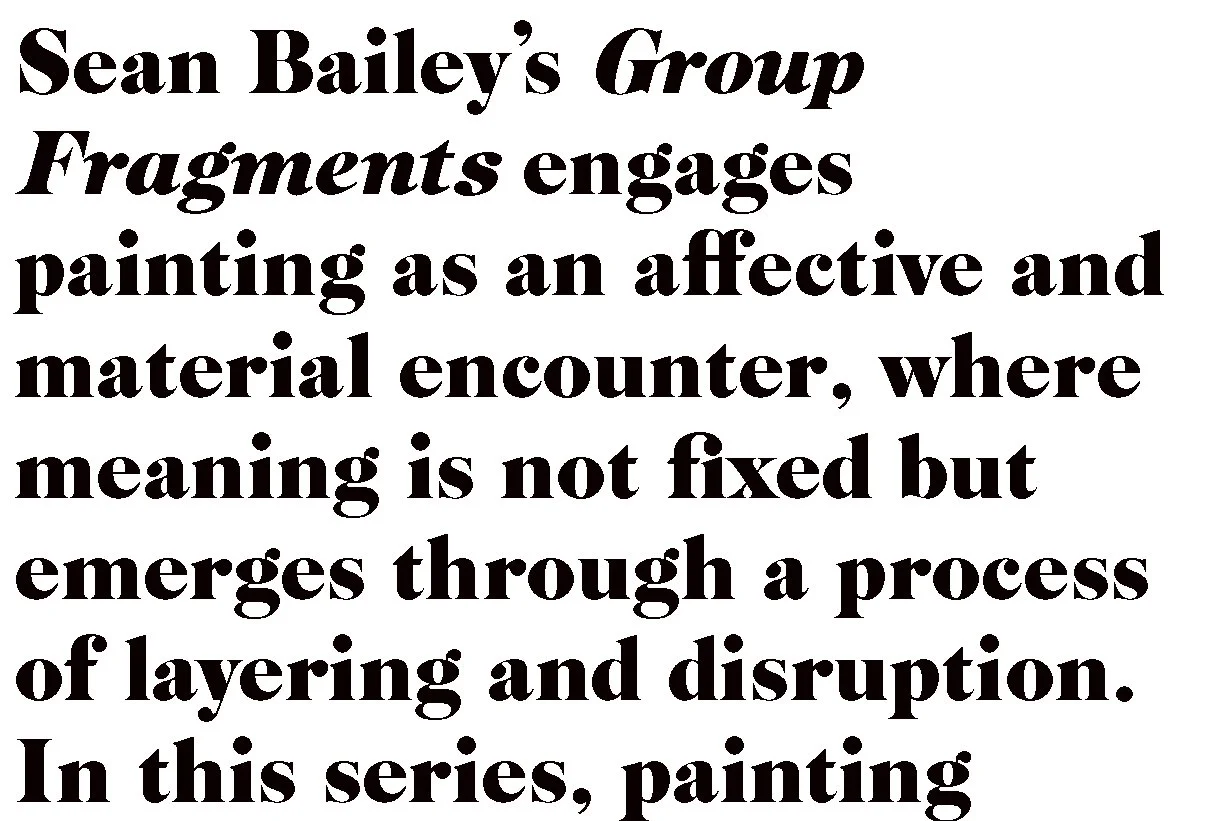Tamsen Hopkinson
’Signal and Static’
Catalogue essay for Sean Bailey Group Fragments
Sean Bailey’s Group Fragments engages painting as an affective and material encounter, where meaning is not fixed but emerges through a process of layering and disruption. In this series, painting operates less as a singular entity and more as a surface that demands a reorientation of perception. Drawing on Sara Ahmed’s work into the politics of feeling and orientation, Bailey’s paintings invite viewers to attune themselves differently; to stay with discomfort, hesitation, and ambiguity rather than seek immediate clarity. Ahmed writes, “Orientations involve a bodily ‘turning toward’ or ‘away from’ something” and “shapes how we inhabit space.”¹ Bailey’s painting’s push for a bodily turning; an embodied and emotional recalibration.
The monoprint, traditionally a direct and singular imprint, becomes for Bailey a provisional residue, immersed beneath different material layers. This treatment fractures the image, making it partial and unstable, echoing Ahmed’s notion that orientations “are shaped by histories of accumulation and sedimentation, of repetition and affect.”² Bailey’s paintings function as sites where viewers must physically and emotionally reorient to negotiate layers of presence and absence. Central to this negotiation is the concept of static; the visual and tactile interference that resists seamless communication. In The Cultural Politics of Emotion, Ahmed proposes that “emotions work to bind bodies together, but they also work to mark boundaries between bodies.”³ The granular textures and interruptions in Bailey’s surfaces activate this circulation, producing moments of hesitation and disruption that destabilize habitual modes of looking and feeling. Static here becomes a productive framework and an invitation to sit in between frequencies.
This affective complexity parallels Ahmed’s reflection on the necessary complicity in engaging with work: “When we have to think strategically, we also have to accept our complicity: we forgo any illusions of purity; we give up the safety of exteriority. If we are not exterior to the problem under investigation, we too are the problem under investigation.’⁴ Bailey’s paintings embrace this complexity as their fractured, layered surfaces reject clear resolution.
The experience of tuning in and out of AM and FM radio further articulates this dynamic. Similar to AM’s vulnerability to interference, Bailey’s underlayers are fragile signals, requiring attentive tuning. FM’s stability and frequency modulation resonate with the repeated motifs and rhythms threading through the works. His paintings are persistent visual orientations that offer points of return amid flux. These motifs act as affective anchors, stabilizing attention without shutting down ambiguity.
Bailey’s paintings enact a palimpsestic process of accretion and erosion, layering and scraping as embodied acts of making and unmaking. This process produces surfaces dense with history, recalling Ahmed’s insistence that orientation is never neutral but shaped by ‘the work of repetition⁵ The muted palette enhances this sense of works unearthed from a field of visual and affective sedimentation.
Group Fragments demands a slow, embodied viewing practice that aligns with Ahmed’s politics of orientation: an openness to discomfort, interruption, and non-linearity. The paintings do not offer fixed meanings but unfold as fields of affect and material trace, where signal and static coexist in tension. They ask: How do we attune ourselves to the partial, the fragmentary, the unresolved? How might we reorient toward images that resist immediate recognition?
In this interplay of transmission and interference, presence and absence, Sean Bailey’s work reimagines painting as a physical encounter; a broadcast that unfolds through materiality, affect, and time.
Sara Ahmed, Queer Phenomenology: Orientations, Objects, Others (Durham: Duke University Press, 2006), 2.
Ahmed, Queer Phenomenology, 15.
Sara Ahmed, The Cultural Politics of Emotion (Edinburgh: Edinburgh University Press, 2004), 20.
Sara Ahmed, On Being Included: Racism and Diversity in Institutional Life (Durham: Duke University Press, 2012), 157.
Ahmed, Queer Phenomenology, 18.
Tamsen Hopkinson (Ngāti Kahungunu, Ngāti Pāhauwera) is an artist and curator from Aotearoa based in Naarm. She is interested in systems of measurement, and the fraught application of these systems to ideas of sovereignty, agency and sound.

